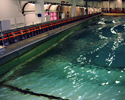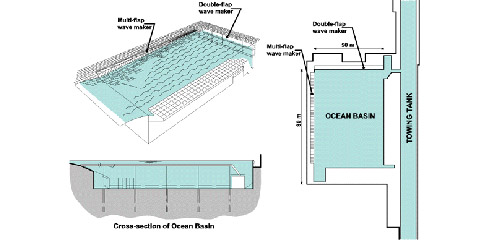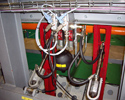
In order to help a company provide the advanced simulation requirements demanded by the marine industry, Moog has supplied advanced hydraulic technology to MARINTEK, a Norwegian Marine Technology Research Institute, located in Trondheim, Norway.
With marine technology advancing on an almost daily basis, there is a huge demand for model testing facilities capable of running highly accurate and reproducible tests. MARINTEK offers one of the biggest ocean-basin laboratories in the world: 80m (262 ft) long, 50 m (164 ft) wide and an adjustable depth of 0 to 10 m (33 ft), it recreates sea conditions using an array of flaps — two on the end and 144 single flaps along its length. In addition, the basin is equipped with a carriage system that caters to free-running models at speeds of up to 5 m/s (16.4 ft/s) at any angle to the waves.
MARINTEK chose Moog as their partner to upgrade the Ocean Basin, built in 1981, with new technology. Their aim was to not only make the system more robust and more reliable but also to provide enhanced capabilities, such as larger waves over a wider area of the basin and more directional flexibility. The most important driver for the upgrade was the need to increase overall performance. Indeed, an accuracy of 0.1 degrees for all flaps was requested to guarantee the creation of highly reproducible waves with a height of up to 0.4m (1.3 ft) in as little as every 1.6 seconds.

Another major requirement was the capability to self-monitor — taking into account not only the cost-per-hour, but also the impact of the test results obtained on human safety and the investments required to build the resulting ships and platforms. The solution had to integrate into the existing environment, especially the waveform computation system and measurement equipment while also offering flexibility to cater for future expansion. Due to the existing 700 kW (952 HP) hydraulic infrastructure a hydraulic solution was the obvious answer.
The solution is built up of 144 hydraulic cylinders, each controlled by a Moog D636 Axis Control Valve (ACV) — a servovalve with axis control capability. With the position sensor of each cylinder being connected directly to the servovalve, the D636 closes the position loop and offers additional features such as self-monitoring of the control loops and the position sensor.

Each group of 12 ACV servovalves is connected via CANopen to a Moog Servo Controller (MSC), a freely programmable motion controller with multiple interfaces such as CANopen, Ethernet and Profibus-DP. The MSC offers two independent CAN interfaces each controlling 6 valves.
The 12 MSCs are connected to the waveform computation system, distributing the set points and the actual position and status information from each valve. In addition to the hardware, the Moog Axis Control Software (MACS) — an IEC 61131-compliant development environment — was used to create the application programs.
Initially, a test system comprising one hydraulic cylinder, a position sensor, an Axis Control Valve and a MSC controller was installed to verify the calculated accuracy and dynamics. Subsequently, with the results fulfilling all requirements, the upgrade of the whole basin commenced.

In total, 12 cabinets were installed along the length of the basin; each containing one MSC, connected via CANopen to 12 D636 Axis Control Valves. Due to the use of a fieldbus, the installation effort was surprisingly low considering the number of devices and the physical size of the system. Indeed, CANopen was selected because of its multi-master capability, its flexibility and functional safety.
"The biggest surprise for me was how easy it was to program this system with all the 144 axes," explains Frank Andersson, senior engineer at MARINTEK. Andersson was involved in the software development from the start of the project, as he wanted to be able to extend the system by himself in the future. As a result of the upgrade, the usable length of the basin for wave testing has been increased — thanks to the accuracy of the flapper movement — a major advance for testing high-speed ships and ferries as the number of test sequences can be reduced.

With the advanced feedback capabilities now available from Moog's ACV range, designers and engineers no longer have to trade force for accuracy and vice versa. Moog's servovalve capabilities are well known throughout the industry and this new technology only serves to reinforce the company's position within the hydraulic market.
Authors
Dieter Kleiner is responsible for customer support and training of M3000 products. He has been working on software development projects for control systems used in industrial and military applications.
Ulf Rasmusson is the Business Manager of North and North-East Europe based in Gothenburg, Sweden. Employed since May 2004, he is responsible for developing and managing the Moog business in the Nordic Area. He holds a Master of Science degree in Electrical Engineering from the Lund University (Sweden) and over 20 years of experience in the Automation Industry.

